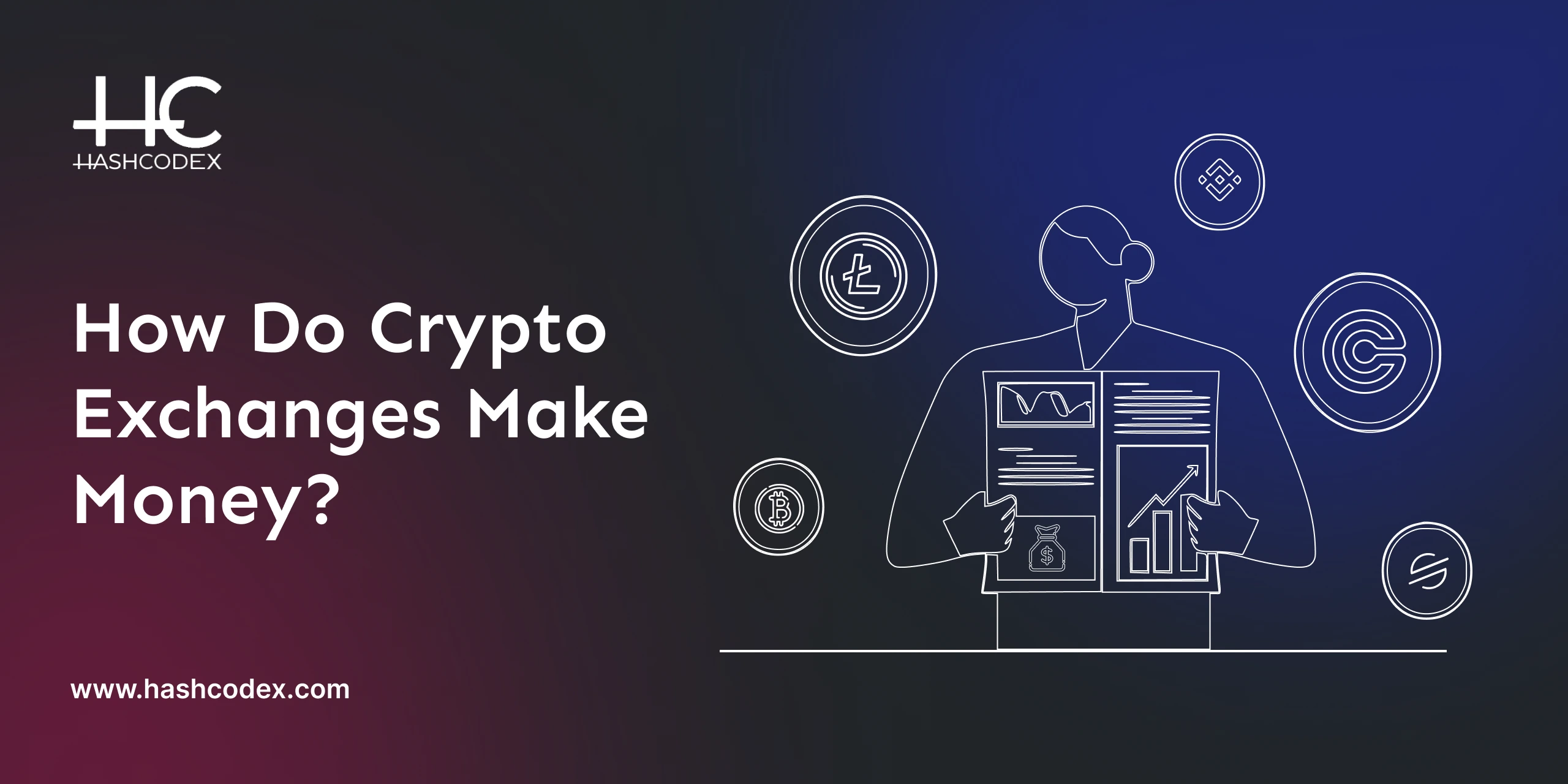
Table of Contents
Every business runs to make money, right? The way they do it may change, but the goal stays the same.
Now, if you're here, you're probably wondering—how do crypto exchanges make money? You might be thinking, “Crypto prices are high, so these platforms must be making huge profits!” But is that really true?
Great question! I had the same thought, so I did some research to find the real answers. And guess what? Crypto exchanges make money in different ways, not just from trading fees.
So, if you want to know how they really make money, stay with me. No long talks—let’s get straight to the point!
How Do Crypto Exchanges Make Money?
Crypto exchanges mostly earn on fees collected on each trade made on its platform. These costs, known as "maker" and "taker" fees, are dependent on the number of trades. There are many other ways to make money.
Let’s explore how crypto exchanges actually make money!
1. Trading Fees – The Main Revenue Source
Every time a user buys or sells crypto, the exchange takes a small cut as a fee. These fees are usually a fixed percentage of the trade value or change based on trading volume.
While it seems small, millions of trades happen daily, making this the biggest source of income for exchanges. Some platforms offer discounts for high-volume traders or for using their native tokens to pay fees.
2. Deposit & Withdrawal Fees – Moving Money Costs
When users add or withdraw money, exchanges charge a fee. Some charge a flat amount, while others take a percentage of the transaction.
Withdrawal fees are usually higher than deposit fees because of blockchain network costs. Some networks, like Ethereum, have higher fees, while others, like Solana, charge less. Users often choose networks with lower withdrawal fees to save money.
3. Listing Fees – Charging Projects to Get Listed
New crypto projects want exposure on big exchanges. But the listing isn’t free! Exchanges charge listing fees, which can range from thousands to millions of dollars. The more popular an exchange is, the higher the fee.
Why? Because listing on a well-known exchange brings more investors and trading volume, making the token more valuable.
4. Market Making – Keeping the Market Active
A crypto exchange needs liquidity, meaning there should always be buyers and sellers. If trading slows, exchanges act as market makers, placing buy and sell orders to keep trades active. This ensures users can always buy or sell crypto without delays.
Exchanges earn through the bid-ask spread, where the buy price is lower and the sell price is higher. The difference is their profit. Even when trading is low, market-making keeps the exchange running while ensuring users always have opportunities to trade.
5. Margin Trading – Borrowing Money to Trade
Some platforms let traders borrow money to trade bigger amounts. This is called margin trading. Exchanges charge interest on loans, earning steady income. Higher leverage means more interest, making it a big revenue source.
6. Staking & Lending – Making Money from Locked Crypto
Many exchanges offer staking, where users lock their crypto to earn rewards. In return, the exchange takes a percentage of those rewards as a service fee.
Another way is crypto lending, where users borrow funds and pay back with interest. This creates passive income for the exchange while keeping users engaged.
💡 Did you know? Coinbase made $214.9 million in staking rewards alone! (Source: CryptoRank)
7. VIP Subscriptions – Extra Features for Paying Users
Some exchanges offer premium plans with exclusive features like trading bots, priority withdrawals, and detailed analytics. Users pay monthly or yearly fees to access these benefits. Think of it as a VIP club where traders pay extra for an edge over others. This provides stable recurring revenue for the exchange.
8. Initial Exchange Offerings (IEOs) – Launching New Coins
Exchanges also help new crypto projects raise funds from investors through Initial Exchange Offerings (IEOs). The exchange hosts the sale, provides security, and gives exposure. In return, they take a cut of the total funds raised.
Many startups prefer IEOs because they attract more investors compared to launching alone.
9. Advertisements & Sponsored Listings – Selling Space
Exchanges sell ad spaces to crypto projects that want more visibility. These ads can appear as banners, promoted tokens, or featured listings.
Since thousands of users visit exchanges daily, advertising fees can be high. Popular exchanges charge premium rates for top placement, turning this into a major revenue stream.
10. API & White-Label Services – Selling Exchange Technology
Some exchanges sell their trading technology to businesses. They offer API access to allow developers to build custom trading tools. Others sell white-label exchange solutions, meaning companies can launch their own exchanges using existing technology. Instead of building a platform from scratch, businesses pay to use a ready-made exchange system.
11. Custody Fees – Storing Crypto Securely
Large investors often store their crypto in secure wallets managed by exchanges. This service, called custody, comes with a fee. Custody fees cover security, maintenance, and handling transactions. Exchanges charge a percentage of stored assets or a fixed monthly fee.
12. Fiat Conversion Fees – Swapping Crypto & Cash
Users often convert fiat (like USD or EUR) into crypto and vice versa. Exchanges charge a small fee per transaction, making fiat conversion a profitable service. The fee depends on currency, exchange rates, and payment method. The more users trade between fiat and crypto, the higher the revenue.
13. Loyalty Tokens – Creating Their Own Coin
Some exchanges launch their own tokens, like Binance’s BNB or Crypto.com’s CRO. These tokens reduce trading fees and offer extra benefits to users. By encouraging traders to use their tokens, exchanges create demand and generate income. When more people buy and hold the token, its value increases, bringing more profits to the exchange.
Extra Revenue through Developing an App for a Crypto Exchange
In addition to trading fees, developing a bitcoin exchange app brings up other revenue streams. The main sources of extra income for cryptocurrency trading platforms are listed below.
Affiliate Programs
- Crypto exchanges can increase their revenue by collaborating with bloggers, influencers, and other platforms through affiliate programs.
- Affiliates receive a fee from each user who registers and trades in exchange for promoting the exchange to their audience.
- This benefits both sides by increasing the user base and compensating affiliates for getting in new traders.
Liquidity Pools
- Exchanges have the option to establish or take part in liquidity pools, where users deposit money to support decentralized trading.
- Liquidity providers receive a portion of the trading fees that the pool generates in exchange.
- To ensure liquidity on the platform and make it an economic business, the exchange can additionally charge a fee for supporting these pools.
Accumulation of Yield
- To optimize profits, consumers can automatically transfer their money between several DeFi protocols via yield aggregation services.
- The exchange could charge a small amount to manage these funds and maximize user returns.
- This service generates income for the platform and offers value by assisting customers in receiving the most returns on their assets.
Financial Product Cross-Selling
- Crypto exchanges can work with outside financial organizations to provide retirement plans, insurance, and loans.
- The exchange receives a commission or fee for each consumer who joins up for these services by cross-selling these items.
- This enhances the platform's function as a one-stop financial center for users and diversifies its income streams.
Exchanges can expand their audience, broaden their financial models, and secure long-term survival in a competitive marketplace by combining many revenue sources. With such possibilities in mind, it is vital to recognize the entire potential of this company.
Extra Profit through Developing an App for a Crypto Exchange
In addition to trading fees, developing a bitcoin exchange app brings up other revenue streams. The main sources of extra income for cryptocurrency trading platforms are listed below.
Affiliate Programs
- Crypto exchanges can increase their revenue by collaborating with bloggers, influencers, and other platforms through affiliate programs.
- Affiliates receive a fee from each user who registers and trades in exchange for promoting the exchange to their audience.
- This benefits both sides by increasing the user base and compensating affiliates for getting in new traders.
Liquidity Pools
- Exchanges have the option to establish or take part in liquidity pools, where users deposit money to support decentralized trading.
- Liquidity providers receive a portion of the trading fees that the pool generates in exchange.
- To ensure liquidity on the platform and make it an economic business, the exchange can additionally charge a fee for supporting these pools.
Accumulation of Yield
- To optimize profits, consumers can automatically transfer their money between several DeFi protocols via yield aggregation services.
- The exchange could charge a small amount to manage these funds and maximize user returns.
- This service generates income for the platform and offers value by assisting customers in receiving the most returns on their assets.
Financial Product Cross-Selling
- Crypto exchanges can work with outside financial organizations to provide retirement plans, insurance, and loans.
- The exchange receives a commission or fee for each consumer who joins up for these services by cross-selling these items.
- This enhances the platform's function as a one-stop financial center for users and diversifies its income streams.
Exchanges can expand their audience, broaden their financial models, and secure long-term survival in a competitive marketplace by combining many revenue sources. With such possibilities in mind, it is vital to recognize the entire potential of this company.
Fee Structure of Popular Crypto Exchanges
Crypto exchanges have several fee structures, including volume-based discounts, deposit and withdrawal fees, and percentage-based fees. Let’s look into the fee structure of the most popular exchanges
Fee Structure of Binance
Binance charges a small fee when users buy or sell crypto. The amount depends on their trading activity and whether they hold Binance Coin (BNB).
Regular Users & Trading Fees
Users who trade less than $1 million in 30 days are considered regular users. Binance applies two types of fees:
- Maker Fee – When users place an order that doesn’t match instantly (like setting a price and waiting).
- Taker Fee – When users buy or sell instantly at the current market price.
For regular users, both the maker and taker fees are 0.1000% per trade. However, if they hold BNB, Binance gives a 25% discount, reducing the fees to 0.0750% per trade.
VIP Users & Lower Fees
Users who trade more than $1 million in 30 days move to VIP levels (VIP 1, VIP 2, etc.). At VIP 1, if they also hold at least 25 BNB, the fees decrease to 0.0900% for maker orders and 0.1000% for taker orders. As users trade higher amounts and reach higher VIP levels, Binance further lowers the fees.
How Binance Rewards Active Traders
Key Takeaways
✔ Regular users pay a fixed fee.
✔ Holding BNB reduces your fees.
✔ VIP users get better discounts based on trading volume.
Binance rewards active traders with lower fees, making it a smart choice for frequent crypto traders.
Fee Structure of Coinbase
Coinbase charges fees when users buy or sell cryptocurrencies. The fees depend on the user's trading volume over the past 30 days and whether the order is a maker or taker.
Regular Users & Trading Fees
- Taker Fee: If a user's order is filled immediately at the market price, they are considered a taker. Taker fees range from 0.05% to 0.60% of the transaction amount.
- Maker Fee: If a user's order is not immediately matched and is placed on the order book, they are considered a maker. Maker fees range from 0.00% to 0.40%.
The exact fee within these ranges depends on the user's total USD trading volume over the past 30 days.
Source:- coinbase
Advanced Trade Fees
For users who use Coinbase's Advanced Trade feature, the fees depend on how much they have traded in the last 30 days (calculated in USD). If the trade is in another currency, Coinbase converts it to USD using the latest market price.
Key Takeaways
- Taker fees: 0.05% to 0.60%
- Maker fees: 0.00% to 0.40%
- Fees decrease as users trade more over a 30-day period.
Coinbase Deposit & Withdrawal Fees
Coinbase allows users to deposit money for free using ACH bank transfers in the U.S. However, wire transfers cost $10 to deposit. If users deposit cryptocurrency, there is no fee from Coinbase, but the blockchain network might charge a small fee.
For withdrawals, ACH bank transfers are free, making them the cheapest option for U.S. users. If users want to withdraw money instantly to a card, Coinbase charges a 1.5% fee (at least $0.55). Wire transfers have a higher fee of $25. Withdrawing cryptocurrency also has a fee, but it depends on the specific coin and network conditions.
Binance Deposit & Withdrawal Fees
Binance does not charge any fees for cryptocurrency deposits, making it free to add funds from a crypto wallet. However, depositing money using fiat (like USD or EUR) may have fees, which depend on the payment method. Users should check Binance’s latest fees before making a deposit.
For withdrawals, Binance charges a fee based on the cryptocurrency being withdrawn. These fees change depending on network conditions. If users withdraw fiat currency, the fee depends on the withdrawal method and the currency used.
How Profitable is it to Run a Cryptocurrency Exchange?
Starting a cryptocurrency exchange is a smart way to make money.
Here’s why:
You earn a small fee every time someone trades on your platform. As more users join, your profits increase. You can also make money from withdrawals, token listings, and extra features. Since crypto trading is growing fast, a well-run exchange can attract thousands of traders.
How do you make it successful?
Focus on three things—security, fast transactions, and great customer support. A simple, easy-to-use platform builds trust and keeps traders coming back. The crypto market is full of opportunities. Start your exchange the right way, and you can build a strong, profitable business!
Final Thoughts
So, after all that talk, here’s the simple truth—crypto exchanges make money in many ways. Every time someone trades, deposits, stakes, or withdraws, the exchange takes a small fee. They also earn from premium memberships, listing new coins, and lending services. No matter if the market is up or down, a well-run exchange keeps making money.
Thinking of starting one? Great idea! A crypto exchange can run 24/7 and be a strong income source if managed well. Just focus on security, trust, and smooth service, and your business can grow in the long run!
Looking for cryptocurrency exchange development services? Hashcodex provides high security and advanced features. Let’s build your exchange—Get in touch today!





